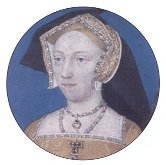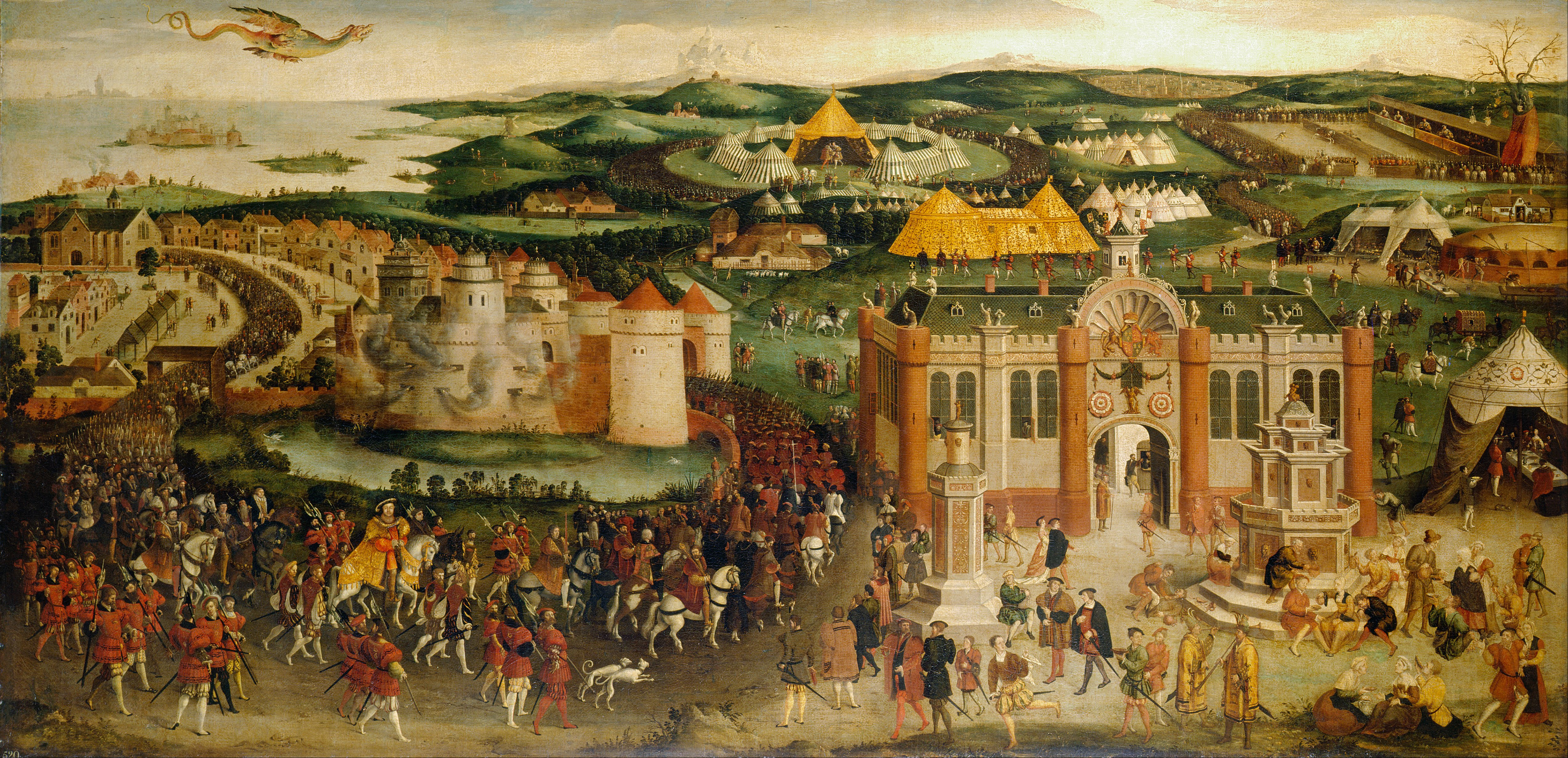|
Arthur, Viscount Lisle
Arthur Plantagenet, 1st Viscount Lisle, KG (died 3 March 1542) was an illegitimate son of the English king Edward IV, half-brother-in-law of Henry VII, and an uncle of Henry VIII, at whose court he was a prominent figure and by whom he was appointed Lord Deputy of Calais (1533–40). The survival of a large collection of his correspondence in the Lisle Letters makes his life one of the best documented of his era. Biography Arthur Plantagenet was born between 1461 and 1475 in Calais, which was then an English possession in France. He died at the Tower of London, where he is buried. The identity of his mother is uncertain; the most likely candidate appears to be the "wanton wench" Elizabeth Wayte, although the historical record is spotty on this issue, and it is not entirely clear that Wayte is distinct from another of Edward's mistresses, Elizabeth Lucy. Another possible candidate is Elizabeth Shore. His godfather was William FitzAlan, 16th Earl of Arundel. He spent his chil ... [...More Info...] [...Related Items...] OR: [Wikipedia] [Google] [Baidu] |
Elizabeth Grey, 6th Baroness Lisle
Elizabeth Grey, 6th Baroness Lisle (c.1482/1484 – c.1525/1526) was an English noblewoman during the reigns of Henry VII and VIII. She is the Grandmother of the disputed Consort of England, Lord Guildford Dudley. Origins Elizabeth Grey was the daughter of Edward Grey, 1st Viscount Lisle (d. 1492) by his wife Elizabeth Talbot (d. 1487), daughter and eventual heir of John Talbot, 1st Viscount Lisle (1423–1453).Byrne, Muriel St Clare, (ed.), The Lisle Letters, London & Chicago, 1981, 6 vols., vol.1, appendix 9, pedigree of Arthur Plantagenet, 1st Viscount Lisle Marriages Elizabeth married twice: * First to Edmund Dudley (c. 1462 – 1510); they had three children: **John Dudley, 1st Duke of Northumberland (c. 1502 – 1553) ** Andrew Dudley **Jerome Dudley *Secondly, after the execution of Edmund Dudley, Elizabeth married Arthur Plantagenet (d. 1542). Arthur and Elizabeth had three daughters: **Frances Plantagenet **Elizabeth Plantagenet **Bridget Plantagenet Succ ... [...More Info...] [...Related Items...] OR: [Wikipedia] [Google] [Baidu] |
Elizabeth Of York
Elizabeth of York (11 February 1466 – 11 February 1503) was List of English royal consorts, Queen of England from her marriage to King Henry VII of England, Henry VII on 18 January 1486 until her death in 1503. She was the daughter of King Edward IV and his wife, Elizabeth Woodville, and her marriage to Henry VII followed his victory at the Battle of Bosworth Field, which marked the end of the civil war known as the Wars of the Roses. Elizabeth's younger brothers, the "Princes in the Tower", mysteriously disappeared from the Tower of London shortly after their uncle Richard III of England, Richard III seized the throne in 1483. Although the 1484 Act of Parliament ''Titulus Regius'' declared the marriage of her parents as invalid, Elizabeth and her sisters returned to court under Richard III, after spending ten months in Right of asylum#Medieval England, sanctuary in Westminster Abbey. It was rumoured that Richard was plotting to marry Elizabeth. The final victory of the Hous ... [...More Info...] [...Related Items...] OR: [Wikipedia] [Google] [Baidu] |
Common Quail
The common quail (''Coturnix coturnix''), or European quail, is a small ground-nesting game bird in the pheasant family Phasianidae. It is mainly migratory, breeding in the western Palearctic and wintering in Africa and southern India. With its characteristic call of three repeated chirps (repeated three times in quick succession), this species of quail is more often heard than seen. It is widespread in Europe and North Africa, and is categorised by the IUCN as "least concern". It should not be confused with the Japanese quail (''Coturnix japonica)'', native to Asia, which, although visually similar, has a call that is very distinct from that of the common quail. Like the Japanese quail, common quails are sometimes kept as poultry. Taxonomy The common quail was formally described by the Swedish naturalist Carl Linnaeus in 1758 in the tenth edition of his ''Systema Naturae'' under the binomial name ''Tetrao coturnix''. The specific epithet ''coturnix'' is the Latin word for th ... [...More Info...] [...Related Items...] OR: [Wikipedia] [Google] [Baidu] |
Jane Seymour
Jane Seymour (; 24 October 1537) was Queen of England as the third wife of King Henry VIII from their marriage on 30 May 1536 until her death the next year. She became queen following the execution of Henry's second wife, Anne Boleyn, who was accused by Henry of adultery after failing to produce a male heir. Jane, however, died of postnatal complications less than two weeks after the birth of her only child, the future King Edward VI. She was the only wife of Henry VIII to receive a queen's funeral; and Henry was later buried alongside her remains in St George's Chapel, Windsor Castle. Early life Jane, the daughter of Sir John Seymour and Margery Wentworth, was most likely born at Wulfhall, Wiltshire, although West Bower Manor in Somerset has also been suggested. Her birth date is not recorded; various accounts use anywhere from 1504 to 1509, but it is generally estimated at between 1508 and 1509. Through her maternal grandfather, she was a descendant of King Edward III's ... [...More Info...] [...Related Items...] OR: [Wikipedia] [Google] [Baidu] |
Thomas Cromwell
Thomas Cromwell (; – 28 July 1540) was an English statesman and lawyer who served as List of English chief ministers, chief minister to King Henry VIII from 1534 to 1540, when he was beheaded on orders of the king, who later blamed false charges for the execution. Cromwell was one of the most powerful proponents of the English Reformation. As the king's chief secretary, he instituted new administrative procedures that transformed the workings of government. He helped to engineer an annulment of the King's marriage to Catherine of Aragon so that Henry could lawfully marry Anne Boleyn. Henry failed to obtain the approval of Pope Clement VII for the annulment in 1533, so Parliament endorsed the king's claim to be Supreme Head of the Church of England, giving him the authority to annul his own marriage. Cromwell subsequently charted an Lutheranism, evangelical and reformist course for the Church of England from the unique posts of Vicegerent in Spirituals and Vicar-general (the t ... [...More Info...] [...Related Items...] OR: [Wikipedia] [Google] [Baidu] |
John Bourchier, 2nd Baron Berners
John Bourchier, 2nd Baron Berners (1467 – 19 March 1533) was an English soldier, statesman and translator. Family John Bourchier, born about 1467, was the only son of Humphrey Bourchier (d. 1471 at the Battle of Barnet) and Elizabeth Tilney (d. 1497), the daughter and sole heir of Sir Frederick Tilney of Boston, Lincolnshire. Through his father, Bourchier was descended from King Edward III; his great-grandmother, Anne of Gloucester, was the daughter of Thomas of Woodstock, King Edward's youngest son. By his mother's first marriage, Bourchier had two sisters, Margaret, who married firstly, John Sandys, secondly, Thomas Bryan, and thirdly, David Zouche, and Anne, who married Thomas Fiennes, 8th Baron Dacre of Gilsland. After the death of the elder Bourchier, his widow, Elizabeth, married Thomas Howard, then Earl of Surrey, and later Duke of Norfolk. By his mother's second marriage Bourchier had ten half-siblings, Thomas Howard, Edward Howard, Edmund Howard, John Ho ... [...More Info...] [...Related Items...] OR: [Wikipedia] [Google] [Baidu] |
Cinque Ports
The confederation of Cinque Ports ( ) is a historic group of coastal towns in south-east England – predominantly in Kent and Sussex, with one outlier (Brightlingsea) in Essex. The name is Old French, meaning "five harbours", and alludes to the original five members (Hastings, New Romney, Hythe, Kent, Hythe, Dover and Sandwich, Kent, Sandwich). At its peak in the Late Middle Ages, the confederation included over 40 members. There is now a total of 14 members: five "head ports", two "ancient towns" and seven "limbs". The confederation was originally formed for military and trade purposes, but is now entirely ceremonial. The ports lie on the western shore of the English Channel, where the crossing to the European continent is narrowest. Inhabitants of the Cinque Ports are called ''Portsmen''. Origins The origins of the confederation are obscure, but are believed to lie in the late History of Anglo-Saxon England, Anglo-Saxon period, and specifically in the reign of Edward the ... [...More Info...] [...Related Items...] OR: [Wikipedia] [Google] [Baidu] |
Knight Of The Garter
The Most Noble Order of the Garter is an order of chivalry founded by Edward III of England in 1348. The most senior order of knighthood in the Orders, decorations, and medals of the United Kingdom, British honours system, it is outranked in United Kingdom order of precedence, precedence only by the Award, decorations of the Victoria Cross and the George Cross. The Order of the Garter is dedicated to the image and Coat of arms, arms of Saint George, England's patron saint. Appointments are at the Monarchy of the United Kingdom, Sovereign's sole discretion, typically made in recognition of national contribution, service to the Crown, or for distinguished personal service to the Monarch. Membership of the order is limited to the sovereign, the Prince of Wales, and no more than 24 living members, or Companions. The order also includes Supernumerary Knights and Ladies (e.g., members of the British royal family and foreign monarchs). The order's emblem is a garter (stockings), gar ... [...More Info...] [...Related Items...] OR: [Wikipedia] [Google] [Baidu] |
Viscount Lisle
The title of Viscount Lisle has been created six times in the Peerage of England. The first creation, on 30 October 1451, was for John Talbot, 1st Baron Lisle. Upon the death of his son Thomas at the Battle of Nibley Green in 1470, the viscountcy became extinct and the barony abeyant. In 1475, the abeyance terminated in favour of Thomas' sister, Elizabeth Talbot, 3rd Baroness Lisle, wife of Edward Grey, 1st Viscount Lisle. Sir Edward was created Viscount Lisle on 28 June 1483, but the title became extinct on the death of their son John in 1504. The viscounty now passed to John's posthumous daughter Elizabeth, whose wardship was granted to Sir Charles Brandon. He contracted to marry her, and was created Viscount Lisle on 15 May 1513 in consequence. Charles Brandon later annulled the contract and married Mary Tudor, Dowager Queen of France, in 1515, surrendering the title Viscount Lisle before 1523. Elizabeth died in 1519 and the barony passed to her aunt, also named Eliza ... [...More Info...] [...Related Items...] OR: [Wikipedia] [Google] [Baidu] |
Field Of Cloth Of Gold
The Field of the Cloth of Gold (, ) was a summit meeting between King Henry VIII of England and King Francis I of France from 7 to 24 June 1520. Held at Balinghem, between Ardres in France and Guînes in the English Pale of Calais, it was an opulent display of wealth by both kings. The summit was arranged to increase the bond of friendship between the two kings following the Anglo-French treaty of 1514. The two monarchs would meet again in 1532 to arrange Francis's assistance in pressuring Pope Clement VII to pronounce Henry's first marriage as illegitimate. Under the guidance of English Cardinal Thomas Wolsey, these European states sought to outlaw war forever among Christian peoples. The Pale of Calais, home to the meeting in Balinghem, was the final English possession in France. This territorial leftover from the Hundred Years' War caused some tensions between the English and French, as the latter preferred a location closer to the border, but topographical consideratio ... [...More Info...] [...Related Items...] OR: [Wikipedia] [Google] [Baidu] |



